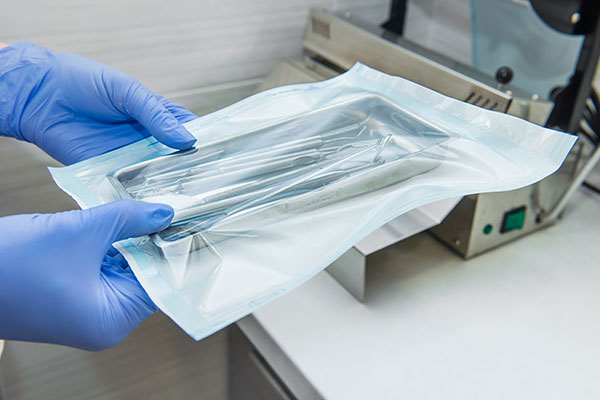Infection control: The Guidelines for the Sterilization and Disinfection of Dental Instruments at San Dimas Family and Sedation Dentistry

The sterilization and disinfection of all equipment and instruments are a part of the infection control protocol all dentists follow. While this has always been important, the COVID-19 pandemic has put it at the front of your mind. Now, you want to know what your dentist does to prevent the transmission of diseases. Your dentist follows a strict protocol based on CDC guidelines. Go over the steps so you will understand what happens behind the scenes.
Sterilization and disinfection protocol
The CDC requires that dentists have a central processing area for sterilizing instruments. This practice must divide the area into sections to prevent cross-contamination. There need to be specific sections for decontamination and packaging. A third section for sterilization and storage is also needed. Dentists bring instruments to the processing area for sterilization and disinfection.
Dental teams wear personal protection equipment when in the central processing area. This prevents the teams from getting bacteria on themselves. It also helps them avoid contaminating the sterilized equipment. This extra layer of protection is critical for infection control.
Cleaning instruments
Dentists clean the instruments before sanitizing them. They use enzymatic cleaners or water and detergent to clean the tools. Cleaning removes material such as organic residue from the instruments. That increases the effectiveness when sterilizing the equipment. After cleaning the items, the dentists pack them in rigid containers.
Then, dentists move the items to the sterilization section. The sterilization method depends on the type of instrument. Dentists have protocols for critical and semi-critical instruments. Following the guidelines is necessary for infection control.
Sterilization and disinfection of critical instruments
Critical instruments include scalers and scalpels. These instruments penetrate the bone or soft tissue. Dental teams must sterilize the items after each use. The CDC requires that dental practices use heat sterilization for infection control. Dentists also have the option of using single-use disposable critical instruments. They throw the tools away after a single use, so sterilization is not necessary.
Sterilizing semi-critical instruments
Semi-critical instruments touch oral tissue but do not penetrate tissue or bone. These instruments include dental impression trays and dental mirrors. The risk of transmission is lower with semi-critical instruments. Still, semi-critical instruments must be high-level disinfected, or heat sterilized after every use. Once sterilized, dentists can use the tools again.
Sterilization monitoring
Dentists use sterilization monitoring to ensure that instruments are properly sterilized. Practices have access to mechanical, biological and chemical indicators. Most dentists use a combination of indicators. Dentists monitor sterilization regularly and fix problems immediately.
Disposable devices
Dentists do not sterilize disposable devices. These devices are meant to be used one time only. Syringe needles, plastic orthodontic brackets and other single-use items cannot be properly cleaned. Dentists dispose of these items after using them a single time.
Dentists play a critical role in infection control
Dentists are on the front lines of infection control by properly sterilizing instruments. Following the CDC’s guidelines for sterilization limits the spread of infectious diseases. This is always critical, including during the COVID-19 outbreak. With proper sterilization, patients are not exposed to bacteria or viruses during procedures.
Request an appointment here: https://sandimassedation.com or call San Dimas Family and Sedation Dentistry at (909) 305-2300 for an appointment in our San Dimas office.
Check out what others are saying about our services on Yelp: Read our Yelp reviews.
Recent Posts
Today, with increasing importance placed on dental aesthetics, there are many reasons why one may consider a trip to the cosmetic dentist. The desire for good-looking teeth is important as beautiful smiles are known to contribute to a person's overall well-being and positive self-image. There are many different avenues for fixing an imperfect smile. In…
An article by GlaxoSmithKline Consumer Healthcare states that more than 18 million people wear partial dentures. Anyone who has been considering getting partials to improve their speech, ability to chew, and even their appearance is not alone. It helps to have the proper information beforehand, though. Partials are created from a wide variety of materials, each…
Dental bridges offer a reliable and effective solution for replacing missing teeth. A missing tooth, whether caused by injury, decay, or other dental issues, can impact the health and appearance of your smile. Fortunately, dental bridges can help restore your oral health. Here are five benefits of choosing dental bridges as your tooth replacement option.Dental…
Individuals suffering from damaged or unsightly teeth may benefit from receiving dental crowns. This straightforward and relatively common procedure can help restore the look and function of healthy, natural teeth. While a variety of components may be used to form dental crowns based on the patient's individual preferences and needs, the installation process is usually…


